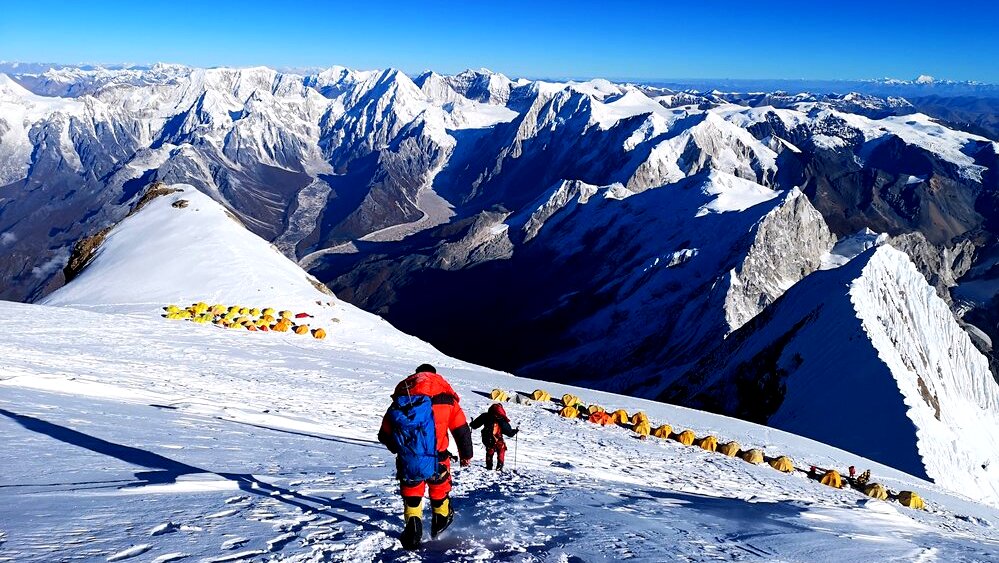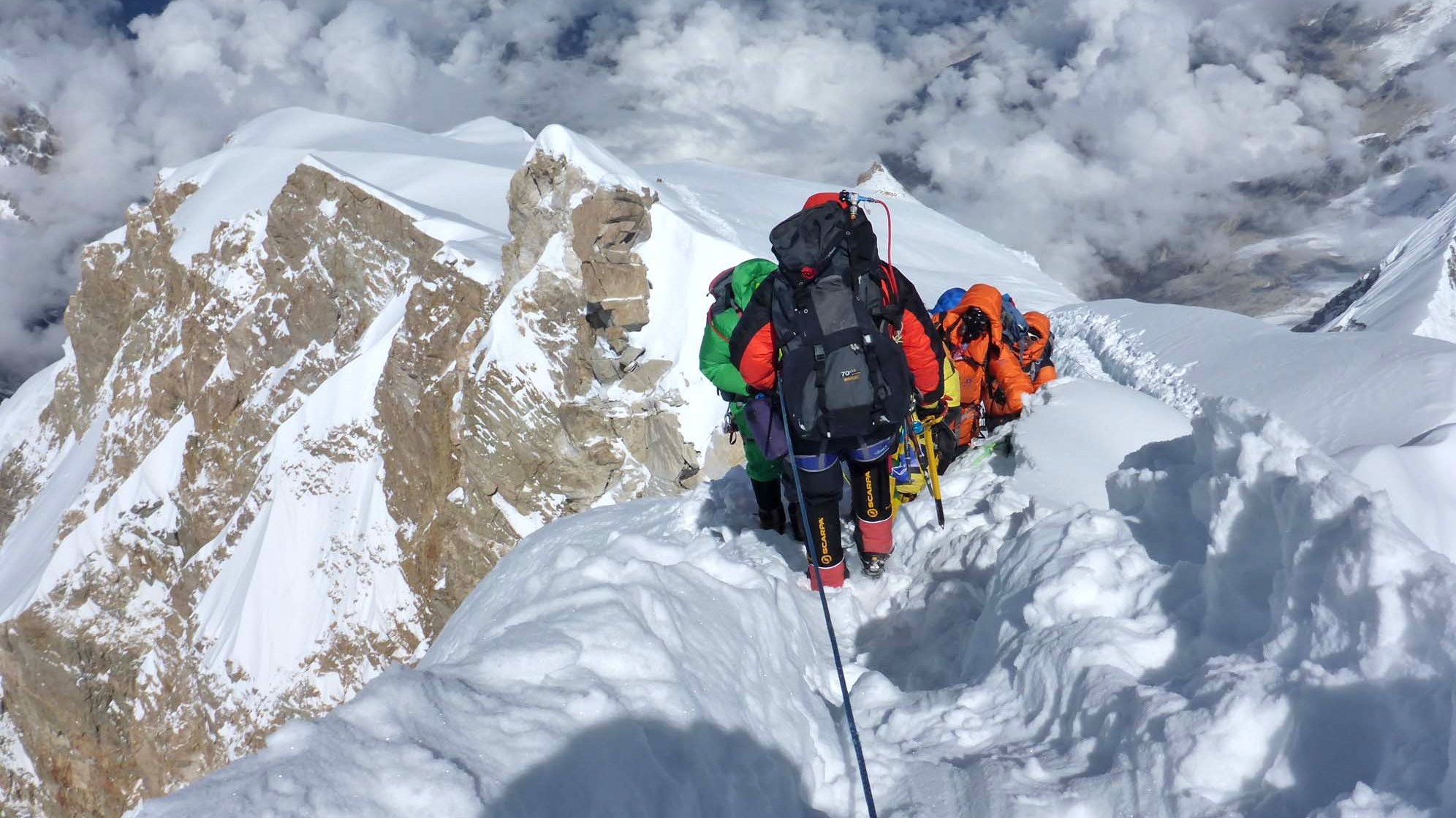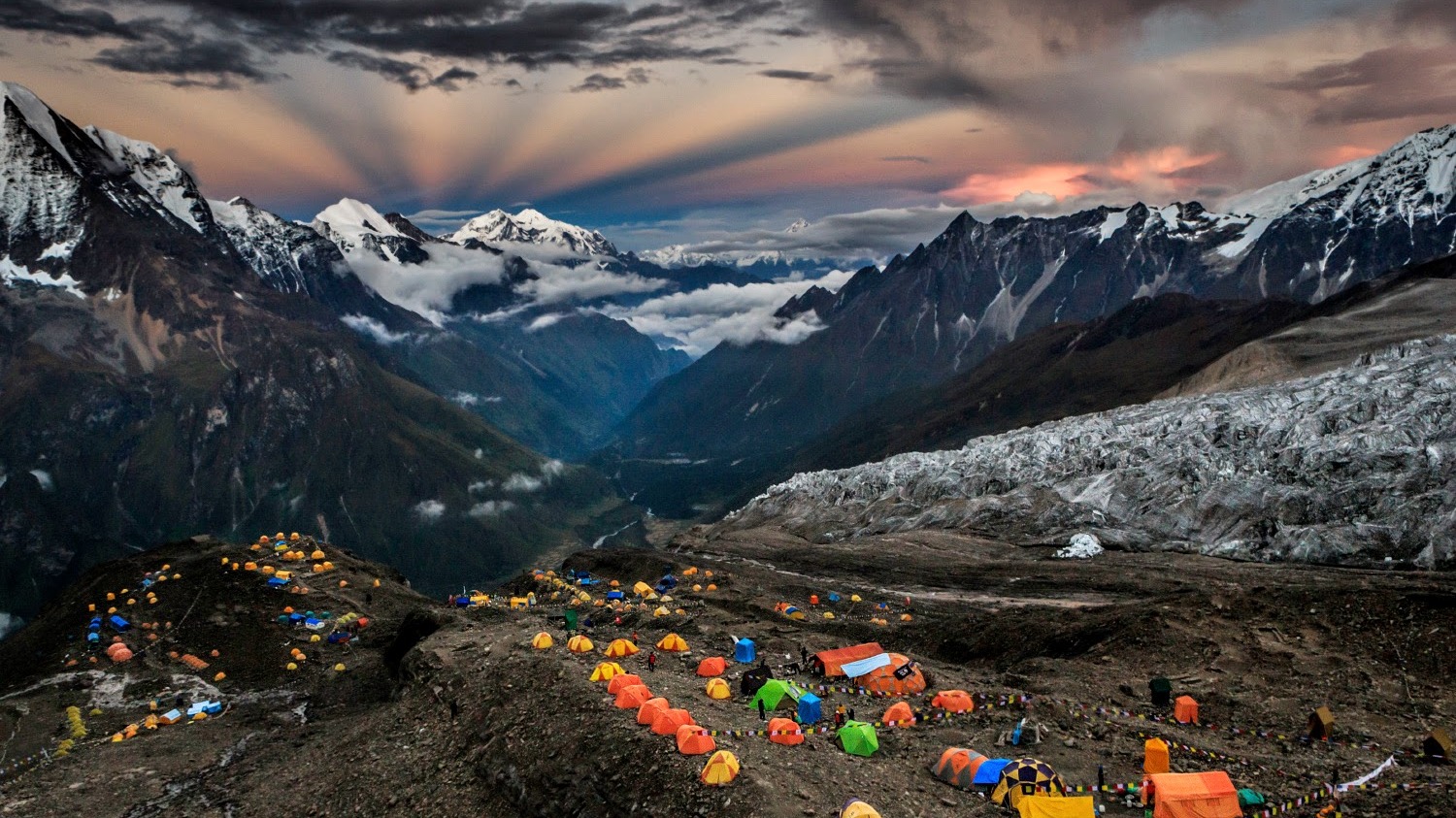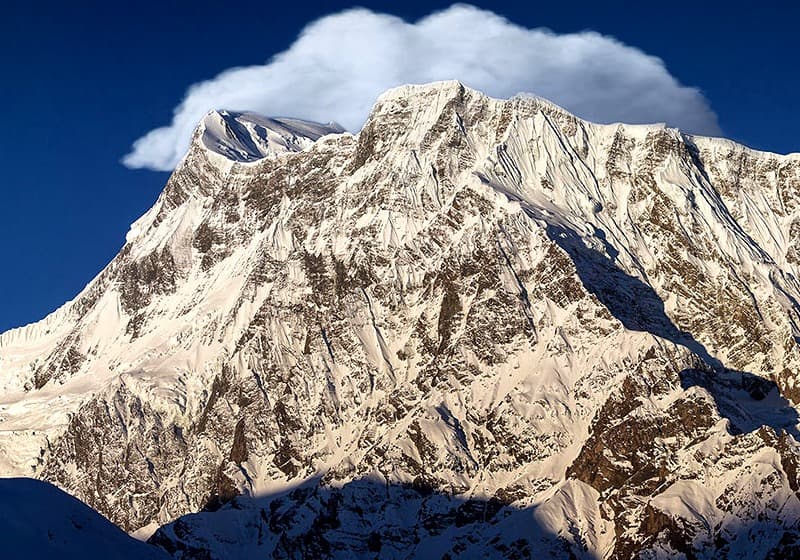Embarking on a journey to summit one of the world's highest peaks is a feat that demands unparalleled determination, skill, and resilience. Among the Himalayan giants, Manaslu stands as an embodiment of both natural beauty and treacherous terrain. As the eighth highest mountain on the planet, its majestic presence lures intrepid climbers seeking to test their mettle against its towering heights. However, the allure of Manaslu is accompanied by an array of formidable challenges that make it a strenuous endeavor even for the most experienced mountaineers.

From its extreme altitude to the technical intricacies of ice and rock climbing, the unpredictable weather, and the scarcity of infrastructure in its remote locale – each aspect adds to the complexity of conquering this peak. Scaling Manaslu requires more than just physical prowess; it demands mental fortitude and strategic planning. Altitude sickness, or acute mountain sickness (AMS), poses a significant hurdle due to decreased oxygen levels, and climbers must carefully acclimatize to these conditions to avoid health risks. Moreover, the mountain's steep and technical sections necessitate advanced mountaineering skills, including navigating crevasses, scaling icy walls, and traversing rocky terrain. As adventurers push themselves to new heights, they also contend with the ever-changing weather that can swiftly transform clear skies into raging snowstorms, rendering the ascent even more arduous and dangerous. Furthermore, Manaslu's remote location in the Nepalese Himalayas amplifies the logistical complexities, forcing climbers to be self-reliant, well-prepared, and environmentally conscious. Despite these daunting challenges, the allure of standing on Manaslu's summit continues to beckon to those who seek the ultimate mountaineering triumph, reminding us that the path to victory is often paved with challenges that test our limits and forge our strength.
Here are the Several factors that contribute to the difficulty level of climbing Manaslu:
Altitude
Altitude sickness is a significant concern for climbers attempting to ascend high-altitude mountains like Manaslu. Altitude sickness, also known as acute mountain sickness (AMS), occurs when the body is exposed to reduced oxygen levels at higher elevations. As you climb to higher altitudes, the air pressure and oxygen concentration in the air decrease, which can lead to various physiological challenges. Here's a more detailed explanation of the effects of altitude sickness:

Symptoms of Altitude Sickness: Altitude sickness can manifest with a range of symptoms that vary in severity. Common symptoms include headaches, dizziness, nausea, vomiting, fatigue, loss of appetite, shortness of breath, difficulty sleeping, and a general feeling of malaise.
Acclimatization: As climbers ascend to higher altitudes, the body needs time to acclimatize to the reduced oxygen levels. Acclimatization involves physiological adaptations that help the body cope with the lower oxygen environment. This process typically involves an increase in red blood cell production, changes in breathing patterns, and adjustments in blood flow.
Types of Altitude Sickness
Altitude sickness can be classified into three main types, depending on the severity of symptoms and their impact on the body:
Acute Mountain Sickness (AMS)
Acute Mountain Sickness (AMS) is the mildest and most common form of altitude sickness. It typically occurs when ascending to altitudes above 2,500 meters (8,200 feet). The reduced oxygen levels at higher altitudes can lead to AMS, especially if climbers ascend too rapidly.
Symptoms of AMS usually appear within 6 to 12 hours of reaching a higher altitude.
Common symptoms include
- Headache: A persistent headache, often described as throbbing or pulsating, is a hallmark symptom of AMS.
- Nausea and Vomiting: Many individuals with AMS experience feelings of nausea and may even vomit.
- Fatigue: Climbers may feel unusually tired or lethargic.
- Loss of Appetite: A reduced desire to eat is common.
- Dizziness or Lightheadedness: Climbers might feel unsteady or dizzy when standing or moving.
While AMS symptoms are generally mild and don't impede climbing progress, it's important to take them seriously. If symptoms worsen or if more severe symptoms appear, it could be an indication of the progression to more severe forms of altitude sickness.
High Altitude Pulmonary Edema (HAPE)
High Altitude Pulmonary Edema (HAPE) is a more serious form of altitude sickness that affects the lungs. It occurs when fluid accumulates in the lungs, impairing their ability to function properly. HAPE can develop quickly, often within the first 2 to 4 days of ascent to high altitudes.
Symptoms of HAPE include
- Shortness of Breath: Climbers may experience difficulty breathing, especially during exertion or while resting.
- Coughing: A persistent cough, often producing pink or white frothy sputum, is common.
- Weakness or Fatigue: Individuals with HAPE might feel weak or unusually tired.
- Rapid Heart Rate: A faster heart rate, even at rest, is a typical symptom.
- Chest Tightness or Pain: Climbers may feel pressure or pain in the chest.
HAPE can be life-threatening if not treated promptly. Descending to lower altitudes, supplemental oxygen, and proper medical care are crucial for managing HAPE.
High Altitude Cerebral Edema (HACE)
High Altitude Cerebral Edema (HACE) is the most severe and dangerous form of altitude sickness, affecting the brain. It occurs when there is swelling of brain tissue due to the effects of high altitude. HACE can develop rapidly, and symptoms may emerge within a few hours to a couple of days.
Symptoms of HACE include
- Severe Headache: The headache associated with HACE is more intense and persistent than that of AMS.
- Confusion or Altered Mental State: Individuals with HACE might become confused, disoriented, or exhibit irrational behavior.
- Difficulty Walking: Loss of coordination and inability to walk in a straight line are common.
- Nausea and Vomiting: Similar to AMS, nausea and vomiting can occur.
- Vision Changes: Blurred vision or seeing double is possible.
HACE is a medical emergency that requires immediate descent to lower altitudes and urgent medical attention.
Risk Factors: The risk of developing altitude sickness depends on several factors, including the rate of ascent, the altitude reached, individual susceptibility, and overall physical condition. Some climbers may be more prone to altitude sickness than others, regardless of their fitness level.
Prevention and Treatment
To minimize the risk of altitude sickness, climbers are advised to follow a gradual ascent profile, allowing their bodies to acclimatize properly. Climbers also need to stay well-hydrated, maintain a balanced diet, avoid alcohol and smoking, and pay attention to their own bodies for any signs of symptoms. If symptoms do develop, descending to a lower altitude is the most effective treatment. Oxygen supplementation and certain medications can also be used to manage symptoms.
Emergency Situations: Severe cases of HAPE or HACE require immediate medical attention and evacuation to lower altitudes. Without prompt treatment, these conditions can become life-threatening.
Monitoring and Awareness: Climbers and expedition leaders should closely monitor all team members for signs of altitude sickness. Proper education about the symptoms, risks, and actions to take is crucial for ensuring everyone's safety.
Given the high altitude of Manaslu, climbers must be well-informed about altitude sickness and its potential effects. Adequate acclimatization, proper climbing strategies, and a cautious approach can help mitigate the risks associated with altitude-related illnesses and enhance the chances of a safe and successful ascent.
Technical Challenges
The technical challenges posed by Manaslu make it a demanding climb that requires advanced mountaineering skills and experience. Here's a more detailed breakdown of some of the technical challenges climbers may face on Manaslu:
Ice and Rock Climbing: Climbers on Manaslu encounter a variety of terrain, including steep ice walls and rock sections. Ice climbing skills are essential for ascending frozen waterfalls and icy slopes. Rock climbing abilities are also crucial for navigating rocky sections, where climbers might need to use ropes, harnesses, and climbing hardware to safely ascend.
Fixed Rope Ascents: Fixed ropes are often installed on particularly steep or exposed sections of the mountain to aid climbers in ascending and descending safely. Climbers need to be proficient in using ascenders, descenders, and other climbing devices to clip onto these fixed ropes and move efficiently.
Crevasses and Seracs: Glaciers on Manaslu can be riddled with crevasses (deep cracks in the ice) and seracs (towering blocks of ice). Navigating these hazards requires careful route finding, roped team travel, and the ability to perform crevasse rescue techniques in case a team member falls into a crevasse.
Avalanche Awareness: Avalanche risk is a concern on many high-altitude peaks, including Manaslu. Climbers need to be knowledgeable about avalanche conditions, be able to assess avalanche terrain, and take appropriate precautions to mitigate the risk.
Weather and Cold Exposure: The extreme altitude of Manaslu brings severe cold temperatures and challenging weather conditions. Climbers must have the skills to manage cold exposure, frostbite prevention, and shelter construction.

Altitude-Related Challenges: The technical difficulties become even more pronounced due to the effects of altitude. Reduced oxygen levels can impair decision-making, coordination, and physical performance, which makes technical climbing tasks even more challenging.
Equipment and Gear: Climbers must have the appropriate technical gear, including crampons, ice axes, harnesses, ropes, helmets, and protective clothing. Familiarity with gear usage and maintenance is vital for safety and efficiency.
Self-Rescue Skills: Climbers need to have self-rescue skills, as well as the ability to assist team members in case of emergencies. This includes skills like performing crevasse rescues, administering first aid, and evacuating injured climbers.
Route Planning and Navigation: Climbers should be skilled at route planning and navigation, as finding the safest and most efficient path up the mountain is critical. Whiteout conditions and poor visibility can make navigation challenging.
Team Coordination and Communication: Climbing Manaslu usually involves working as part of a team. Effective communication, teamwork, and coordination are essential for managing risks and making collective decisions.
Weather
The weather conditions on Manaslu can be highly unpredictable and harsh, adding another layer of challenge to the climb. The Himalayas, including Manaslu, are known for their dynamic and often severe weather patterns that can impact climbers' safety and progress. Here's a more detailed look at the weather challenges climbers may face on Manaslu:
Rapid Weather Changes: The weather in Manaslu can change rapidly and unexpectedly. Clear skies can suddenly give way to heavy snowfall or intense storms, making it essential for climbers to be prepared for sudden shifts in conditions.
High Winds: Strong winds are common at high altitudes, and they can be particularly intense on mountains like Manaslu. High winds not only make climbing more difficult and energy-consuming but also increase the risk of frostbite and cold exposure.
Snowfall: Heavy snowfall is a common occurrence in the Himalayas. Snow accumulation can create challenging conditions for climbing, making the terrain more difficult to navigate and increasing the risk of avalanches.
Avalanche Risk: The combination of steep slopes, heavy snowfall, and unstable snowpack can lead to a significant avalanche risk on Manaslu. Climbers need to be well-trained in assessing avalanche conditions and choosing safe routes.
Visibility Challenges: Poor visibility due to snow, clouds, or fog can make route finding and navigation extremely challenging. Climbers may need to rely on GPS, compasses, and other navigational tools to stay on course.
Temperature Extremes: Temperatures at high altitudes can drop well below freezing, especially during the night. This extreme cold can lead to frostbite and hypothermia if climbers are not adequately prepared with appropriate clothing and gear.
Altitude Effects: The physiological effects of high altitude, such as decreased oxygen levels and reduced physical performance, can be exacerbated by harsh weather conditions. Climbers may tire more easily and have reduced mental clarity during adverse weather events.
Safe Window for Summit Attempts: Due to the unpredictability of the weather, climbers often need to wait for a suitable weather window to make summit attempts. This requires careful monitoring of weather forecasts and strategic planning to optimize the chances of a successful ascent.
Exposure and Risk Management: Harsh weather conditions increase the risk of exposure-related injuries and illnesses. Climbers need to manage their exposure to the elements through proper clothing, shelter, and risk mitigation strategies.
Communication Challenges: In remote and high-altitude areas like Manaslu, communication infrastructure can be limited. Climbers and expedition teams may struggle to communicate with base camp, support teams, or emergency services during inclement weather.
Here is more information about the four seasons in Nepal
- Spring (March to May): Spring is a popular time to climb Manaslu. The weather starts getting warmer, and the snow begins to melt, making routes more accessible. However, unexpected snowfalls and strong winds can still occur.
- Summer (June to August): Summer is not recommended for climbing due to heavy rainfall, slippery trails, and avalanche risk. The weather is milder, but the conditions are hazardous and unsuitable for climbing.
- Autumn (September to November): Autumn is considered the best time for Manaslu climbing. The weather is stable with clear skies, and temperatures are manageable. However, cold increases as the season progresses, and snow accumulates.
-
[block](72)

- Winter (December to February): Winter is the most challenging season for climbing. Extremely cold temperatures, heavy snowfall, and fierce winds make climbing risky and difficult. Climbers usually avoid attempting the summit during this period.
Given the unpredictable nature of the weather on Manaslu, climbers and expedition leaders must prioritize safety and make well-informed decisions based on weather forecasts and conditions. Flexibility, preparedness, and the ability to adapt to changing weather are essential attributes for anyone attempting to climb this challenging peak. Climbers should also be mentally prepared for the possibility of delays or changes in their climbing plans due to unfavorable weather conditions.
Remote Location
The remote location of Manaslu adds an additional layer of complexity to climbing the mountain. The logistical challenges, limited infrastructure, and potential difficulties in accessing necessary resources and rescue services can make the expedition more demanding.
Logistical Complexity: Manaslu's remote setting makes organizing transportation, permits, equipment, and supplies more intricate and time-consuming. This complexity demands meticulous planning and coordination to ensure a successful expedition.
Limited Infrastructure: Unlike popular climbing destinations, Manaslu has fewer established facilities like lodges and communication infrastructure. Climbers must be prepared to bring their own gear and rely on expedition support to set up the necessary infrastructure.
Supply Scarcity: Access to essential supplies, such as food, fuel, and medical equipment, can be limited in the remote areas around Manaslu. Expeditions need to carry sufficient provisions for the entire climb due to challenges in resupplying.
Rescue and Communication Challenges: Injuries and medical emergencies can be especially problematic due to the remote location and challenging terrain. The difficulty in arranging timely rescue operations is compounded by limited communication options and potential weather-related obstacles.
Environmental Responsibility: The remote location emphasizes the importance of responsible climbing practices to minimize environmental impact. Climbers must adhere to Leave No Trace principles and respect local customs and traditions while appreciating the natural beauty of the area.
Permit Restrictions
Permit restrictions play a significant role in regulating climbing on Manaslu. Here's a concise explanation of this aspect:
Regulatory Permits: Climbing Manaslu necessitates obtaining permits from the Nepalese government. These permits are essential for legal access to the mountain and its surrounding areas.
Limited Climber Numbers: The government imposes a cap on the number of climbers allowed on Manaslu each climbing season. This limitation is in place to manage the environmental impact and ensure the safety of both climbers and the mountain environment.
Environmental Impact Management: By limiting the number of climbers, authorities aim to minimize the ecological impact on the fragile mountain ecosystem. Overcrowding can lead to issues such as waste accumulation, damage to flora, and degradation of the landscape.
Safety Considerations: Permit restrictions also contribute to the safety of climbers. With fewer climbers on the mountain, there is less congestion on routes and at camps, reducing the risk of accidents and increasing overall safety.
Maintaining Experience Quality: The limited number of climbers helps maintain the quality of the climbing experience. A less crowded mountain environment can lead to a more serene and authentic climbing experience.
Lack of Infrastructure
- Unestablished Routes: Manaslu has fewer established and well-traveled routes compared to more popular peaks like Everest or Annapurna. Climbers may need to navigate uncharted or less frequently climbed paths, which require strong route-finding skills and a heightened sense of navigation.
- Base Camp Facilities: Base camps on Manaslu may have less developed facilities compared to those on more frequented peaks. Climbers may need to set up their own tents, manage their cooking arrangements, and ensure their own comfort and safety.
- Lodging and Amenities: Unlike the lodges and teahouses found on more popular routes, climbers on Manaslu might have fewer options for lodging and amenities along the way. This means they need to carry more of their own gear and supplies and be prepared for a higher degree of self-sufficiency.
- Communication Challenges: The lack of established infrastructure can also result in limited communication options. Climbers might have difficulty staying in touch with base camp, coordinating logistics, or reaching out for assistance in case of emergencies.
- Emergency Services: In case of injuries or medical emergencies, climbers might have to rely more on their team members and the limited resources available in the area. Evacuations and medical assistance could be more challenging to arrange due to the lack of infrastructure.
- Environmental Responsibility: With fewer established facilities, climbers must take extra care to minimize their environmental impact. This includes practices such as waste disposal, respecting local customs, and adhering to Leave No Trace principles.
- Self-Reliance and Skills: Climbers attempting Manaslu must be more self-reliant and possess a wider range of mountaineering skills. This includes setting up camp, preparing food, managing equipment, and performing basic medical care.
- Route Preparation: Climbing on a peak with less established infrastructure demands more thorough preparation. Climbers and expedition organizers need to plan meticulously to ensure they have the necessary gear, supplies, and contingency plans in place.
- Expedition Team Skills: The lack of infrastructure underscores the importance of having a skilled and experienced expedition team. This includes mountaineers, guides, porters, and support staff who are familiar with the challenges and can help address them effectively.
- Cultural Engagement: With less developed infrastructure, climbers are likely to have more interactions with local communities. It's important to engage with these communities respectfully and responsibly, recognizing the impact of tourism on their way of life.
FAQs of What is the difficulty level of climbing Manaslu?
Q: How difficult is it to climb Manaslu?
A: Climbing Manaslu is considered highly challenging due to its extreme altitude, technical terrain, unpredictable weather, and remote location. It requires advanced mountaineering skills, physical fitness, and mental resilience.
Q: What are the technical challenges of climbing Manaslu?
A: Climbing Manaslu involves navigating steep ice and rock sections, using fixed ropes for ascents, and maneuvering through crevasses and seracs. These technical challenges demand experience in ice and rock climbing, as well as rope and safety skills.
Q: How does altitude affect the climb?
A: The high altitude of Manaslu presents physiological challenges, including decreased oxygen levels. Climbers must acclimatize carefully to prevent altitude sickness and related illnesses, which can impact performance and safety.
Q: What role does the weather play in the difficulty?
A: Manaslu's weather is unpredictable and harsh, with rapid changes, heavy snowfall, and strong winds. Climbers must be prepared for adverse conditions that can complicate the ascent and increase the risk of frostbite and avalanches.
Q: How does Manaslu's remote location add to the difficulty?
A: Manaslu's remote setting leads to logistical challenges in obtaining permits, arranging transportation, and accessing supplies. Climbers need to be more self-reliant, prepare for limited infrastructure, and navigate the absence of established routes and facilities.
Q: Are there permit restrictions for climbing Manaslu?
A: Yes, climbing Manaslu requires obtaining permits from the Nepalese government. The number of climbers allowed each season is limited to manage environmental impact and ensure safety.
Q: What skills and experience are necessary to climb Manaslu?
A: Climbers need advanced mountaineering skills, including ice and rock climbing, rope techniques, crevasse rescue, and navigation. Prior high-altitude experience and physical fitness are also crucial.
Q: Is climbing Manaslu suitable for beginners?
A: Manaslu is not recommended for beginners due to its technical challenges, altitude, and harsh conditions. Climbers should have extensive mountaineering experience on less demanding peaks.
Q: How do climbers mitigate the risks of climbing Manaslu?
A: Climbers mitigate risks through thorough training, proper acclimatization, careful planning, knowledgeable expedition leaders, and a strong understanding of avalanche safety and emergency procedures.
Q: What motivates climbers to attempt Manaslu despite its difficulty?
A: The allure of conquering a challenging peak, testing personal limits, and experiencing the breathtaking beauty of the Himalayas are powerful motivations for climbers to undertake the formidable journey up Manaslu.
If you need any further information, please contact us by email: [email protected], Phone: +977- 985 100 5129 (WhatsApp)




